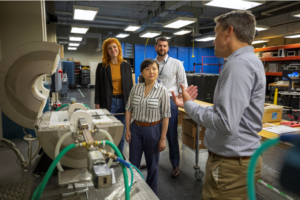
Improving sensor systems for hypersonic vehicles is a critical focus area for a team of researchers led by Dr. Ellen Mazumdar, an expert in diagnostic techniques and sensor systems at the Georgia Institute of Technology. Mazumdar and her team are leading research into hypersonic window materials with funds awarded in 2020 by the Department of Defense via the University Consortium for Applied Hypersonics administered by the Texas A&M Engineering Experiment Station.
One of the project’s goals is to determine how to collect quality measurements with smaller sample sizes. A single full-size material sample can cost upward of tens of thousands of dollars to produce. Thus, by reducing the required sample sizes, testing costs can be reduced and design cycles can be shortened.
The project’s second goal is to investigate strategies for improving hypersonic materials. Hypersonic window designers are often constrained by emissivity properties, and most of the research in this area currently focuses on minimizing thermal emission at high temperatures. Mazumdar and her team are taking a unique approach and researching self-calibrating materials. Once the favorable materials are selected, they will be tested at high temperatures and extreme flow conditions.
This pivotal research is beneficial for the field of hypersonics as it explores new opportunities for cost efficiency without sacrificing reliability. By reducing the size of the sample, the cost per sample decreases significantly. This also allows more conclusive and frequent testing of materials to determine their material resiliency to higher temperatures and more extreme loading. The biggest challenges the team will address include developing novel measurement concepts as well as developing materials that can withstand extreme temperatures.
The research findings also have the potential to be applied to lower-speed vehicles or space re-entry vehicles, leading to safer commercial and space flight.


